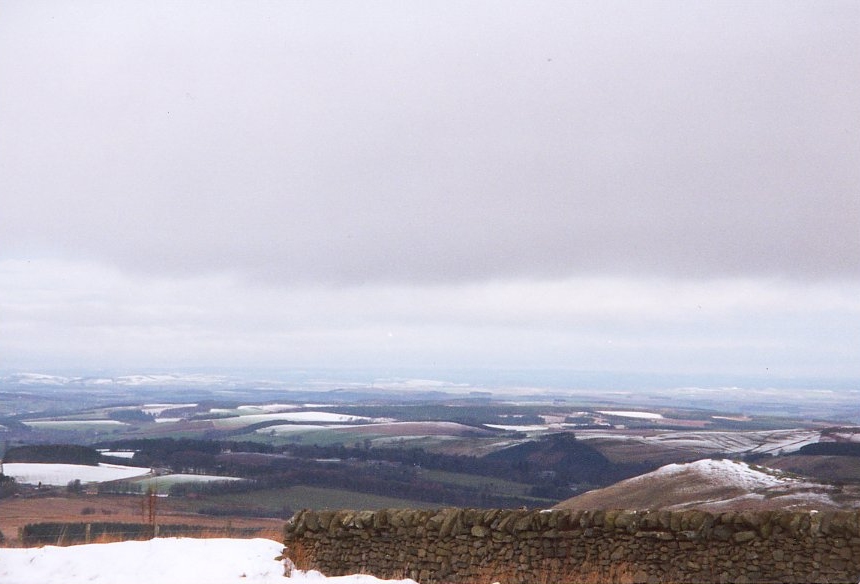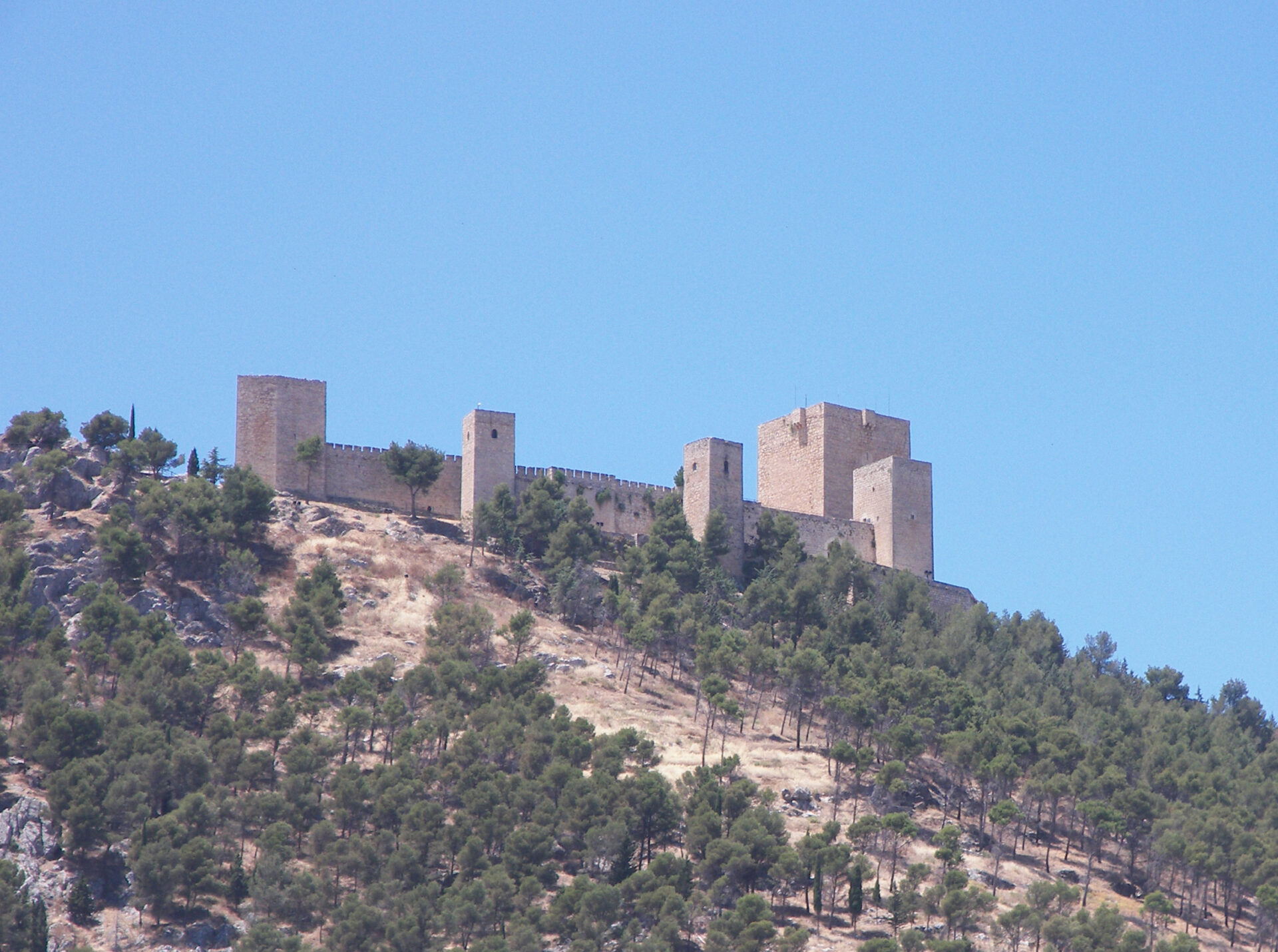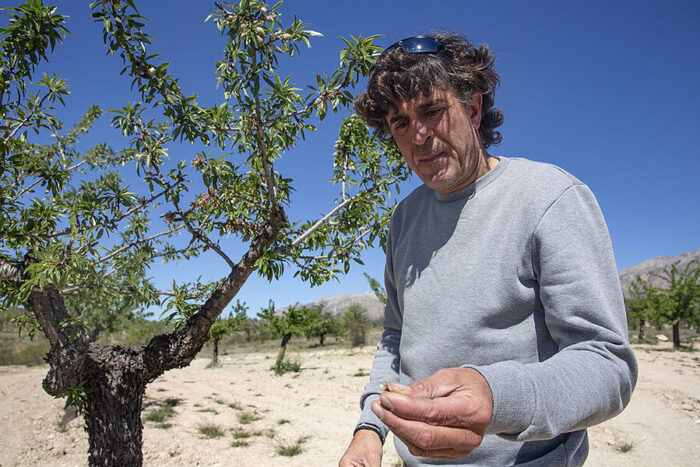Why medieval frontiers might matter: a case study
It is, of course, pretty crucial to the foundational set-up of this project that medieval frontiers might still matter now. In some cases the basis for this is obvious: for example, if you are heading north from England to Scotland, as you should at any opportunity, and proceed by the A68, you have the chance to stop at a viewpoint on the English-Scottish border, where once you are sufficiently dazzled by the amazing view, the signage will also inform you that you are standing at one of the oldest borders in the world
. By this, given a reference to it being there for nearly a thousand years, they seem to be referring to the aftermath of the Battle of Carham in 1018, which may or may not have transferred Lothian from English to Scottish rule.1 Actually that date is disputed, but since everyone seems to agree that Lothian was in Scotland by the 1090s, and certainly by the time Adam of Dryburgh could refer to his abbey as being in the land of the English and the Kingdom of the Scots
around 1180, the point is probably still good; that viewpoint is where it is because of decisions made by medieval people.2 How much that actually matters to anything that went on round it for the subsequent 900-1000 years might be the next research question, of course, and on that there is work, but the point is (hopefully) made.3

View of Scotland from the Carter Bar border crossing, by Beefy_SAFC (talk) (Uploads) - Own work, Public Domain via Wikimedia Commons
My more usual research interests would also demand that I point out that the area we now call Catalonia is differentiated from the rest of the Iberian Peninsula primarily because from around 785 to around let's-say-987-for-simplicity's-sake it was a marca, march or frontier zone, of the Carolingian Empire, which is why it has not just an Occitan-family language rather than an Iberian one but also why so much of its political history has emphasised links across the Pyrenees rather than into the Peninsula. The frontier of France and Spain was only set on the Pyrenees in 1659, but that was not a massive change from the 1258 Treaty of Corbeil. That line, too, is medieval, though again we might reasonably argue that the line is not the final definition of the situation here.4

And that is why Perpignan's rugby team is called the Catalan Dragons, or at least it's why they're called Catalan; logo borrowed from their website, linked through
But this is surface-level stuff, made only of dates and battles, not of the lived practice by which modern work tells us frontiers are made, not of the borderwork
and bordering
which build borderscapes
and so forth; and while I may despair slightly of the neologisms, the point seems valid to me.5 And that work, while it teaches us that borders do very much affect people's lives, also teaches us that it doesn't necessarily do so in the ways that the makers of the borders expected.6 So can we show that medieval frontiers have mattered or even do matter in these deeper fashions? I've just read something that argues that we can, so I thought I should share. The work in question is a fairly hefty article (45 pages and a 52-page data appendix!) entitled Historical Frontiers and the Rise of Inequality
, by Daniel Oto-Peralías and Diego Romero-Ávila, from 2017, and its focus, as the subtitle indicates, is The Case of the Frontier of Granada
.7 I mentioned it a post or two ago, and said it needed separate attention; this is that.

The castle of Santa Catalina, Jaén, one of the principal fortresses on the Castilian-Granadan frontier, image by Kordas - own work, licensed under CC BY-SA 3.0, via Wikimedia Commons
Now, a lot of this article is statistics and mathematics. A decent part of it, even, is mathematics perpetrated in order to convince statisticians that the author's mathematics are statistical, and to be honest by my lights it's unnecessary as the raw data they have tells the story fine by itself.8 That story, once you extract it from the maths, goes roughly like this:
- Pace Frederick Jackson Turner whom we were just talking about, not every frontier is a space for egalitarian settler opportunity, as settlement isn't necessarily carried out by a plethora of social equals; this one was at least partly settled by military fiat and so structures of social dependency were carried straight into it.9
- Nonetheless, the Castilian kingdom and the Nasrid emirate of Granada sat either side of roughly the same frontier line for most of a century, and obviously Castilian settlement didn't proceed beyond it while that situation endured, so that military fiat settlement applied primarily to the zone north of the frontier, whereas once the Nasrids had been forced to surrender, the military imperative was removed and settlement beyond the old frontier line proceeded, firstly, slowly, and, secondly, with the iniative more or less at ground-level.10
- This had effects on land tenure and jurisdiction that were still visible in the early modern period, in census records of 1787 much of whose land tenure (the authors argue) goes back to the late medieval situation of two-and-a-bit centuries before, and still in the modern era from parallel data of 1982.11 It is why, they argue, Andalucia still has more migrant and landless labour, less wealth and flatter social hierarchies than the Extremadura.12
In other words the inequalities of the modern situation in southern Spain were set up centuries ago, by,
a political equilibrium defined by a high concentration of power in the hands of a military elite, which was reinforced by the fact of it being an insecure border region.13
Now, I have reservations about a lot of the method here. Using 1787 records as proxies for the situation on a freshly unstable medieval frontier is dodgy; there is a bunch of data in the appendix for the medieval situation whose origin is completely unexplained but still gets used in calculations; and at least one of their measures, concentration of judicial rights, is damaged by their own falsification checks but they use it anyway.14 Furthermore, I have reservations about some of the deductions from the data even with those first reservations overlooked: the argument they are making is that development and population growth were held back in Andalucia by the inequality of land tenure set up by the defensive frontier situation, but what their data shows is (first point) that settlement was and is more egalitarian in Andalucia but it's still much poorer, even though (second point) the population density there was and is higher than in the Extremadura.15 Secondly, that dodgy measure of concentration of judicial rights is probably meaningless anyway, since it seems to me from the data they give that it was as significant on the Nasrid side of the border as it was on the Castilian one, so presumably isn't germane to any differences.16 And thirdly, though maybe least importantly, as their citation makes clear, the bit of this that looks like a theoretical insight, the quarrel with Turner about the effects of social structure on the frontier settlement dynamic (with which I'm pretty sure Turner himself would have agreed, given how he emphasised the uniqueness of the American situation), isn't actually these authors' own but comes from a different paper by Camilo García-Jimeno and James A. Robinson.17 So it is possible that a quite different set of conclusions might be drawn from all this data and, indeed, that in order to draw safe conclusions you'd need to collect data differently from this, and it would be mean but easy to say that this is what happens when you let people used to quantitative methods, like economists, go play in the Middle Ages where there usually isn't any or it isn't comparable.18
But to be honest, I'm not sure all of that matters for the big point. That point is that there are lasting social differences between Andalucia and other areas of Spain, which can be documented at least two-thirds of the way back to the Middle Ages when a frontier lay between the two zones, a frontier about whose divisive effects we are pretty well informed.19 It seems inane to argue that the situation today has other origins than the fact that Andalucia was the last Muslim-held territory in the Peninsula and was taken over wholesale by a medieval state which had dedicated centuries to building up institutions to govern territory conquered from the Muslims; we can argue about whether the effects here are correctly identified and deduced, but it really is a question of whether this is a good attempt to fill in what must go in this space, not whether there should or should not be something in it. All this modern work I cite tells us that situations like this do have effects, and not just "fun" ones like weird enclaves and exclaves.20 These may or may not be effects that this situation had; but the attempt to determine what those were is valid, and it's almost a shame that the authors had to start with a justification of the idea that there would have been effects.21

"Juan Garcia Chacon examines his almonds on April 26 in El Cortijuelo, Almeria, Spain. He grows almond trees for a living and has modified farming methods used on the family farm in a bid to battle desertification." Image by Dominique Sogel, from Dominique Sogel, "As southern Spain dries up, its farmers get inventive", Christian Science Monitor, 17 May 2019 <https://www.csmonitor.com/World/Europe/2019/0517/As-southern-Spain-dries-up-its-farmers-get-inventive>
And if this medieval frontier so obviously mattered and matters, why should others matter less? Perhaps that is a question that has answers, in which case sure, let's gather them; but even doing so will tell us a lot about what effects frontier situations like ours have and had and how they needed countering. For Oto-Peralías and Romero-Ávila the significant thing about this frontier is in part that Spain never really bothered countering the effects; but in other places, by necessitating such action, it could be argued that the frontiers there had more effect on the society of which they were the edges, not less.22 And eventually, I hope, we'll get to the point where those effects and counter-effects will be sufficiently clear to us that we can show them to the modernists and geographers and political scientists and say, hey: you have places where your models don't really work, I know. Try these?
1. For the traditional view of that battle and its significance see Rannoch Daly, Birth of the Border: The Battle of Carham 1018 AD: Scotland and England and the Tweed Betwixt (Alnwick: Wanney Books, 2018), but compare Alex Woolf, From Pictland to Alba, 789– 1070, New Edinburgh History of Scotland, 2 (Edinburgh: Edinburgh University Press, 2007), pp. 232-240.
2. George Molyneaux, The Formation of the English Kingdom in the Tenth Century (Oxford: Oxford University Press, 2015), pp. 1-9, citing Adam of Dryburgh, De tripartito tabernaculo, ii.13, in Patrologia Latina, ed. J. P. Migne (221 vols, Paris, 1844-64), cxcviii, column 23. That cite makes me wince for the battles George must have had with his copy-editors, but it is certainly useful enough for me to steal it!
3. Geoffrey Barrow, Frontier and Settlement: Which Influenced Which? England and Scotland, 1100-1300
, in Medieval Frontier Societies, ed. by Robert Bartlett and Angus MacKay (Oxford: Clarendon Press, 1989), pp. 3–21; Kate Ash-Irisarri, Scotland and Anglo-Scottish Border Writing
, in Medieval Historical Writing: Britain and Ireland, 500–1500, ed. by Jennifer Jahner, Emily Steiner, and Elizabeth M. Tyler (Cambridge: Cambridge University Press, 2019), pp. 225–43 <https://doi.org/10.1017/9781316681299>.
4. For the end of the process, see Peter Sahlins, Boundaries: The Making of France and Spain in the Pyrenees (Berkeley: University of California Press, 1989) and indeed Zoe Bray, Boundaries and Identities on the Franco-Spanish Frontier
, CIBR Working Papers in Border Studies (Belfast: Centre for International Borders Research, Queen’s University Belfast, 2002) <https://www.qub.ac.uk/research-centres/CentreforInternationalBordersResearch/Publications/WorkingPapers/CIBRWorkingPapers/Filetoupload,174413,en.pdf<; for before that, try Aymat Catafau, La frontière, une « calamité féconde » pour les Comtés nord-catalans au Moyen Âge
, in « Comme une étoffe déchirée » : Les Catalognes avant et après le traité des Pyrénées, ed. by Gracia Dorel-Ferré (presented at the Premières rencontres d'histoire de l'Association Française des Catalanistes, 9-10 octobre 2008, Canet: Trabucaire, 2012), pp. 19–30 <https://www.academia.edu/10587754/_La_frontière_une_calamité_féconde_pour_les_Comtés_nord_catalans_au_Moyen_Âge_Comme_une_étoffe_déchirée_Les_Catalognes_avant_et_après_le_traité_des_Pyrénées_F_Corrons_E_Trenc_G_Dorel_Ferré_dir_2012_p_19_30>, and indeed the other papers in that volume if you can get it, or soon, I hope, a readable version of Margault Coste, Living on the Frontier of 1258 between France and Aragon
(unpublished conference paper, presented at Rethinking the Medieval Frontier, University of Leeds, 10 April 2018)!
5. I do tend to cite Chiara Brambilla, Exploring the Critical Potential of the Borderscapes Concept
, Geopolitics, Borderscapes: From Border Landscapes to Border Aesthetics, 20.1 (2015), 14–34 <https://doi.org/10.1080/14650045.2014.884561> for language like this, because it is rich in it, but in this instance I think there is some use for it, and so do others, in this case Victor Konrad, Jussi P. Laine, Ilkka Liikanen, James W. Scott and Randy Widdis, The Language of Borders
, in Handbook of the Changing World Language Map, ed. by Stanley D. Brunn and Roland Kehrein (Zürich: Springer Nature Switzerland, 2018), pp. 1–17 <https://doi.org/10.1007/978-3-319-73400-2_52-1>, or more anciently Borderscapes: Hidden Geographies and Politics at Territory’s Edge, ed. by Prem Kumar Rajaram and Carl Grundy-Warr, Borderlines, 29 (Minneapolis, MI: University of Minnesota Press, 2007) <https://zodml.org/sites/default/files/[Prem_Kumar_Rajaram%2C_Carl_Grundy-Warr]_Borderscape_0.pdf>.
6. Sahana Ghosh, Relative Intimacies: Belonging and Difference in Transnational Families
, Economic and Political Weekly, Exploring Borderlands in South Asia, 52.15 (2017), 45–52 (p. 51, my emphasis): As several elderly residents put it, they have not started doing anything new or different by way of marriage practices or observance of kinship relations. It is the border that happened to them and turned their lives into transnational ones.
7. Daniel Oto-Peralías and Diego Romero-Ávila, Historical Frontiers and the Rise of Inequality: The Case of the Frontier of Granada
, Journal of the European Economic Association, 15.1 (2017), 54–98 <https://doi.org/10.1093/jeea/jvw004>.
8. Ibid., pp. 70-75 is almost all statistics and checking processes; pp. 89-93 give an account of the variables they use, and App. pp. 6-49 are visualisations of the data.
9. Ibid., pp. 55-58.
10. Ibid., pp. 59-70.
11. Ibid., pp. 70-87.
12. Ibid., pp. 57-58.
13. Ibid., p. 58.
14. Ibid., p. 65 vs. pp. 75-79.
15. Ibid., pp. 81-82 and (for the relative population density) App. pp. 1-2.
16. Ibid., p. 64 vs. pp. 66-67.
17. Camilo García-Jimeno and James A. Robinson, The Myth of the Frontier
, in Understanding Long-Run Economic Growth: Geography, Institutions, and the Knowledge Economy, ed. by Dora L. Costa and Naomi R. Lamoureaux, National Bureau of Economic Research Conferences (Chicago, IL: University of Chicago Press, 2011), pp. 49–88 <http://ndl.ethernet.edu.et/bitstream/123456789/44131/1/4.Dora L. Costa.pdf>, cited by Oto-Peralías & Romero-Ávila, Historical Frontiers
, p. 55.
18. See Jonathan Jarrett, Outgrowing the Dark Ages: Agrarian Productivity in Carolingian Europe Re-Evaluated
, Agricultural History Review, 67.2 (2019), 1–28 (pp. 20-21 and 24), citing as cautionary material esp. J. Z. Titow, Winchester Yields: A Study in Medieval Agricultural Productivity, Cambridge Studies in Economic History, 2nd edn. (Cambridge: Cambridge University Press, 2002), pp. 7-9, reproduced in Bruce M. S. Campbell and David Hardy, The Data
, Three Centuries of English Crop Yields, 1211-1491, n. d. <http://www.cropyields.ac.uk/project.php>.
19. See esp. José Enrique López de Coca Castañer, Institutions on the Castilian-Granadan Frontier
, in Medieval Frontier Societies, ed. by Robert Bartlett and Angus MacKay (Oxford: Clarendon Press, 1989), pp. 127–50, but also Angus MacKay, Religion, Culture, and Ideology on the Late Medieval Castilian-Granadan Frontier
, ibid., pp. 217–43; Diego Melo Carrasco, Notas en torno a la violencia fronteriza. Castilla y Granada durante los siglos XIII-XV: conflictos e instituciones
, in La Edad Media Peninsular: Aproximaciones y problemas, ed. by Ángel Gordo Molina and Diego Melo Carrasco (Gijón: Ediciones Trea, 2017), pp. 143–66; Ignacio Díaz-Sierra, Guarding the Frontier: Castilian Settlers on the Border with Granada in the Fifteenth Century
, Journal of Medieval Iberian Studies, 10.3 (2018), 385–402 <https://doi.org/10.1080/17546559.2018.1464200>; and Yuga Kuroda, La vida y diplomacia local en la frontera castellano-granadina: Casos de Cazorla y Jérez de la Frontera del siglo XV
, in Beyond the Seas: a Medievalists’ Meeting in Tokyo (Allende los mares: un encuentro de medievalistas en Tokio)『海を越えて:⻄洋中世学論集』, ed. by Junko Kume (presented at the III Coloquio Internacional "La Edad Media vista desde otros horizontes", Tokyo University of Foreign Studies, October 2017, Tokyo: Tokyo University of Foreign Studies—Institute for Global Area Studies, 2019), pp. 67–82 <http://repository.tufs.ac.jp/bitstream/10108/93437/1/igas_kume_06.pdf>.
20. Radhika Gupta, Allegiance and Alienation: Border Dynamics in Kargil
, in Borderland Lives in Northern South Asia, ed. by David Gellner (Durham, NC: Duke University Press, 2013), pp. 47–71 <https://oapen.org/download?type=document&docid=625238>; Debidatta Aurobinda Mahapatra, From Alienation to Co-Existence and Beyond: Examining the Evolution of the Borderland in Kashmir
, Journal of Borderlands Studies, 33.1 (2018), 141–55 <https://doi.org/10.1080/08865655.2016.1238316>.
21. Oto-Peralías & Romero-Ávila, 'Historical Frontiers', pp. 55-58 & App. pp. 1-3, the latter a quite neat review of frontiers historiography that never really gets pulled into the wider argument, but is more clearly relevant than the immediately following review of the Brenner debate, pp. 4-5, which isn't used at all in the main article.
22. Pekka Hämäläinen and Samuel Truett, On Borderlands
, Journal of American History, 98.2 (2011), 338–61 <https://doi.org/10.1093/jahist/jar259>, and somewhere behind them (cited p. 343 n. 12), of course, Gloria Anzaldúa, Borderlands / La Frontera: The New Mestiza, 4th edn (San Francisco: Aunt Lute Books, 2012).
